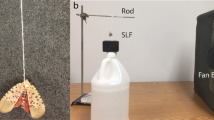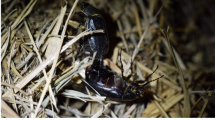Abstract
Foraging is an extremely important behaviour for birds, especially during the breeding season, when they have to carry the cost of incubation and chick rearing, in addition to their own energy needs. Aerial insectivores perform most of their foraging behaviours in flight, so they have evolved various adaptations to reduce energy output whilst increasing energy input during this critical period. In this study, we recorded the 3D flight behaviours of 100 house martins (Delichon urbicum) flying near their colony during the breeding season in Rennes, France. We give a first description of the distribution of several kinematic and biomechanical variables (horizontal and vertical speed, rates of change in kinetic and potential energy, turning radius of curvature and centripetal force), compare flapping and gliding flight, and describe several strategies used by flying house martins to save energy, such as environmental energy extraction (thermal soaring) and optimisation of flight speed according to wind speed and direction. We also report an effect of temperature, solar radiation and humidity on the mean vertical speed of gliding birds, highlighting the effect of weather on the availability of external energy sources such as thermal updrafts. Finally, we compare the distribution of flight speed and vertical speed between 5 juveniles identified using magnified photographs and 20 adults recorded during the same field sessions, and we show that during flapping flight, juveniles exhibit higher, more variable airspeed than adults, suggesting that their flight behaviours are not immediately fine-tuned after leaving the nest.
Significance statement
Aerial insectivores use various strategies to reduce the cost of foraging flight. Using an optical tracking method, we recorded the 3D flight behaviours of house martins (Delichon urbicum) flying near their colony during the breeding season. We describe the distribution of several biomechanical variables and show that house martins use external energy sources such as thermal updrafts and also adapt their airspeed to wind speed and direction, supporting the predictions on optimal cost of transport in birds. Moreover, juveniles were also recorded, and they show a greater variability in flight speed, possibly because they may not be as accurate as adults in finely adjusting their speed and altitude. Our findings add to the existing literature showing energy-saving strategies in aerial insectivores, and also study an ontogenetical aspect rarely explored.

Source for aerial view: Google Earth







Similar content being viewed by others
Data availability
The flight trajectory and environmental data used as a basis for this analysis are publicly available from the Figshare digital repository: https://doi.org/10.6084/m9.figshare.21118408.v1
References
Bechtold B (2016) Violin plots for Matlab, Github Project, https://github.com/bastibe/Violinplot-Matlab
Blasco-Zumeta J, Heinze GM (2014) Atlas de Identificación de las Aves de Aragón, http://blascozumeta.com/specie_files/10010_Delichon_urbicum_E.pdf
Brown MB, Brown CR (2020) Barn swallow (Hirundo rustica), version 1.0. In: Billerman SM, Keeney BK, Rodewald PG, Schulenberg TS (eds) Birds of the world. Cornell Lab. of Ornithology, Ithaca, NY, USA
Bryant DM (1973) The factors influencing the selection of food by the house martin (Delichon urbica (L.)). J Anim Ecol 42:539–564
Bryant DM (1979) Reproductive costs in the house martin (Delichon urbica). J Anim Ecol 48:655
Bryant DM, Turner AK (1982) Central place foraging by swallows (Hirundinidae): the question of load size. Anim Behav 30:845–856
Bryant DM, Westerterp KR (1980) The energy budget of the house martin (Delichon urbica). Ardea 68:91–102
Bustamante J (1994) Behavior of colonial common kestrels (Falco tinnunculus) during the post-fledging dependence period in southwestern Spain. J Raptor Res 28:79–83
de Margerie E, Simonneau M, Caudal JP, Houdelier C, Lumineau S (2015) 3D tracking of animals in the field using rotational stereo videography. J Exp Biol 218:2496–2504
de Margerie E, Pichot C, Benhamou S (2018) Volume-concentrated searching by an aerial insectivore, the common swift, Apus apus. Anim Behav 136:159–172
del Hoyo J, Turner A, Kirwan GM, Collar N (2020) Common house-martin (Delichon urbicum), version 1.0. In: Billerman SM, Keeney BK, Rodewald PG, Schulenberg TS (eds) Birds of the world. Cornell Lab. of Ornithology, Ithaca, NY, USA
Gall MD, Hough LD, Fernández-Juricic E (2013) Age-related characteristics of foraging habitats and foraging behaviors in the black phoebe (Sayornis nigricans). Southwest Nat 58:41–49
Geerts B, Miao Q (2005) Airborne radar observations of the flight behavior of small insects in the atmospheric convective boundary layer. Environ Entomol 34:361–377
Gory G (2008) Le régime alimentaire du martinet noir Apus apus en région méditerranéenne. Rev Ecol-Terre Vie 63:251–260
Hedenström A, Alerstam T, Green M, Gudmundsson G (2002) Adaptive variation of airspeed in relation to wind, altitude and climb rate by migrating birds in the Arctic. Behav Ecol Sociobiol 52:308–317
Hedrick TL (2008) Software techniques for two- and three-dimensional kinematic measurements of biological and biomimetic systems. Bioinspir Biomim 3:034001
Hedrick TL, Pichot C, de Margerie E (2018) Gliding for a free lunch: biomechanics of foraging flight in common swifts (Apus apus). J Exp Biol 221:jeb186270
Heyes CM (1994) Social learning in animals: categories and mechanisms. Biol Rev 69:207–231
Hyndman RJ, Athanasopoulos G, Bergmeir C, Caceres G, Chhay L, O’Hara-Wild M, Petropoulos F, Razbash S, Wang E, Yasmeen F (2022) forecast: forecasting functions for time series and linear models. R package version 8.16, https://cran.r-project.org/web/packages/forecast/forecast.pdf
Hyndman RJ, Khandakar Y (2008) Automatic time series forecasting: the forecast package for R. J Stat Soft 27:1–22
Kacelnik A, Houston AI (1984) Some effects of energy costs on foraging strategies. Anim Behav 32:609–614
Kitowski I (2009) Social learning of hunting skills in juvenile marsh harriers Circus aeruginosus. J Ethol 27:327–332
Kogure Y, Sato K, Watanuki Y, Wanless S, Daunt F (2016) European shags optimize their flight behavior according to wind conditions. J Exp Biol 219:311–318
Lack D, Owen DF (1955) The food of the swift. J Anim Ecol 24:120
Marchetti K, Price T (1989) Differences in the foraging of juvenile and adult birds: the importance of developmental constraints. Biol Rev 64:51–70
Markman S, Pinshow B, Wright J (2002) The manipulation of food resources reveals sex–specific trade–offs between parental self-feeding and offspring care. Proc R Soc Lond B 269:1931–1938
Pennycuick CJ (1978) Fifteen testable predictions about bird flight. Oikos 30:165–176
Pennycuick CJ (2008) Modelling the flying bird. Academic Press, London
Poessel SA, Brandt J, Miller TA, Katzner TE (2018) Meteorological and environmental variables affect flight behaviour and decision-making of an obligate soaring bird, the California condor Gymnogyps californianus. Ibis 160:36–53
R Core Team (2021) R: A Language and Environment for Statistical Computing. R Foundation for Statistical Computing, Vienna, Austria, http://www.R-project.org
Rayner JMV (1982) Avian flight energetics. Annu Rev Physiol 44:109–119
Ruaux G, Lumineau S, de Margerie E (2020) The development of flight behaviours in birds. Proc R Soc B 287:20200668
Shaffer SA, Costa DP, Weimerskirch H (2003) Foraging effort in relation to the constraints of reproduction in free-ranging albatrosses: foraging effort of free-ranging albatrosses. Funct Ecol 17:66–74
Shelton RM, Jackson BE, Hedrick TL (2014) The mechanics and behavior of cliff swallows during tandem flights. J Exp Biol 217:2717–2725
Shepard ELC, Lambertucci SA, Vallmitjana D, Wilson RP (2011) Energy beyond food: foraging theory informs time spent in thermals by a large soaring bird. PLoS One 6:e27375
Sinelschikova A, Griffiths M, Vorotkov M, Bulyuk V, Bolshakov C (2019) Airspeed of the song thrush in relation to the wind during autumnal nocturnal migration. Ornis Fenn 96:64–76
Sokal R, Rohlf FJ (1981) Biometry, 2nd edn. Freeman and Co, New York
Varland DE, Klaas EE, Loughin TM (1991) Development of foraging behavior in the American kestrel. J Rapt Res 25:9–17
Wainwright CE, Stepanian PM, Reynolds DR, Reynolds AM (2017) The movement of small insects in the convective boundary layer: linking patterns to processes. Sci Rep 7:5438
Wakeling JM, Hodgson J (1992) Short communication: optimisation of the flight speed of the little, common and sandwich tern. J Exp Biol 169:261–266
Warrick DR, Hedrick TL, Biewener AA, Crandell KE, Tobalske BW (2016) Foraging at the edge of the world: low-altitude, high-speed manoeuvering in barn swallows. Phil Trans R Soc B 371:20150391
Whittingham LA, Lifjeld JT (1995) High paternal investment in unrelated young: extra-pair paternity and male parental care in house martins. Behav Ecol Sociobiol 37:103–108
Ydenberg RC (1994) The behavioral ecology of provisioning in birds. Écoscience 1:1–14
Acknowledgements
We would like to thank J. Blasco-Zumeta who helped us to confirm our identifications of juvenile house martins. We thank J. J. Young and S. Windsor (Bristol Univ., UK) who improved our original RSV device design (de Margerie et al. 2015), and designed a second-generation device, upon which the present RSV device is based. We also thank two reviewers that helped to improve this manuscript.
Funding
Research on bird flight supervised by EdM was supported by a grant from the Mission for Transversal and Interdisciplinary Initiatives at the CNRS in 2018, and an Emerging scientific challenge grant from the Rennes University in 2020, which made it possible to acquire some of the material used in this study.
Author information
Authors and Affiliations
Corresponding author
Ethics declarations
Ethics approval
This is an observational study, without any animal manipulation or disturbance.
Conflict of interest
The authors declare no competing interests.
Additional information
Communicated by B. Voelkl
Publisher's note
Springer Nature remains neutral with regard to jurisdictional claims in published maps and institutional affiliations.
Supplementary Information
Below is the link to the electronic supplementary material.
Rights and permissions
Springer Nature or its licensor (e.g. a society or other partner) holds exclusive rights to this article under a publishing agreement with the author(s) or other rightsholder(s); author self-archiving of the accepted manuscript version of this article is solely governed by the terms of such publishing agreement and applicable law.
About this article
Cite this article
Ruaux, G., Monmasson, K., Hedrick, T.L. et al. Flight behaviours and energy savings in adult and juvenile house martins (Delichon urbicum) foraging near their breeding colony. Behav Ecol Sociobiol 77, 63 (2023). https://doi.org/10.1007/s00265-023-03332-8
Received:
Revised:
Accepted:
Published:
DOI: https://doi.org/10.1007/s00265-023-03332-8




